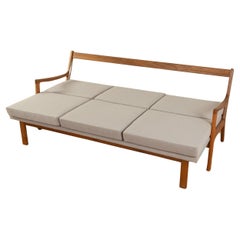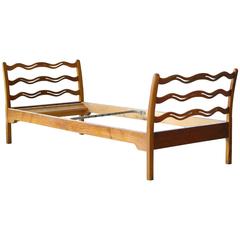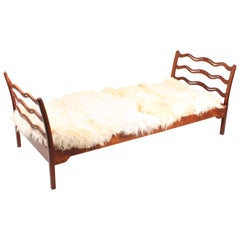Ole Wanscher Daybed
Vintage 1960s Danish Scandinavian Modern Daybeds
Fabric, Teak
Recent Sales
Vintage 1940s Danish Mid-Century Modern Daybeds
Beech
Vintage 1950s Danish Scandinavian Modern Daybeds
Beech
Vintage 1940s Danish Mid-Century Modern Daybeds
Metal
21st Century and Contemporary Finnish Scandinavian Modern Daybeds
Leather, Cotton, Oak
People Also Browsed
Mid-20th Century Finnish Mid-Century Modern Lounge Chairs
Aluminum
21st Century and Contemporary Moroccan Organic Modern Doors and Gates
Brass
Mid-20th Century Danish Mid-Century Modern Game Tables
Teak
21st Century and Contemporary American Mid-Century Modern Wall Lights an...
Brass
21st Century and Contemporary French Mid-Century Modern Wall Lights and ...
Metal, Aluminum
Late 20th Century French Mid-Century Modern Wardrobes and Armoires
Glass, Wood, Oak
Vintage 1960s German Mid-Century Modern Flush Mount
Metal, Brass
21st Century and Contemporary American Mid-Century Modern Jewelry Boxes
Maple, Walnut
Antique Early 1900s German Art Nouveau Cabinets
Other
21st Century and Contemporary American Mid-Century Modern Chandeliers an...
Aluminum, Brass
Vintage 1970s Italian Mid-Century Modern Sofas
Leather, Suede
2010s American Industrial Wardrobes and Armoires
Steel, Iron
Vintage 1940s Italian Sideboards
Wood
Vintage 1960s Swedish Mid-Century Modern Carts and Bar Carts
Brass
21st Century and Contemporary American Mid-Century Modern Chandeliers an...
Brass
Mid-20th Century Italian Mid-Century Modern Benches
Steel
Ole Wanscher Daybed For Sale on 1stDibs
How Much is a Ole Wanscher Daybed?
Ole Wanscher for sale on 1stDibs
A scholar and architect with the heart of an artist, Ole Wanscher helped define the functional, clean-cut style that formed the core of modern Danish furniture design. Influenced heavily by his world travels, Wanscher gained inspiration from English, Asian, Egyptian and traditional Shaker furniture, and he incorporated elements from these styles into his revered mid-century designs.
Wanscher’s deep respect for the use of traditional materials such as quality wood is reflected in his work, which is valued for being both beautiful and built to last. He was also a leader in the postwar “design for everyone” movement, creating many pieces intended for everyday life within the small confines of the average Danish household. Later, Wanscher became a prolific writer on the subject of furniture design. He is considered one of the most significant influences on the world of Scandinavian modernism.
The son of an art historian and a painter, Wanscher studied at the Royal Danish Academy of Fine Arts. From 1925 to 1927, Wanscher worked under the great Danish designer and professor Kaare Klint, who became one of the greatest stylistic influences on his output. Wanscher would go on to work as a professor at the academy from 1955 to 1973.
Wanscher founded his own furniture manufacturing company in 1929. Here he employed the top cabinetmakers of the day, most notably A.J. Iversen, with whom Wanscher collaborated for many years. While the workshop produced seductive handmade furniture with organic materials such as teak and mahogany, Wanscher intended to design durable seating, tables and more for the mass market — he was committed to making quality furniture available to a wider audience.
Of all of Wanscher’s designs, he is perhaps best known for his Colonial chair. This piece — which is part of a collection for Danish manufacturer P. Jeppesens that includes a sofa and a coffee table — exemplifies his penchant for combining minimalist design with traditional craftsmanship. Wanscher’s dining room tables, such as the Rungstedlund table, also epitomize the elegance of his work’s simple silhouettes and careful construction. These sleek tables serve as an ideal centerpiece for both modern and traditionally styled dining rooms, highlighting the versatility of Wanscher’s work.
Wanscher received a gold medal for his exemplary work at the 1960 Milan Triennale. He also received the Copenhagen Carpenters’ Guild Annual Award. Though Wanscher passed away in 1985, his iconic designs and scholarly writings remain relevant to this day.
Find vintage Ole Wanscher tables, seating and case pieces on 1stDibs.
Finding the Right Day-beds for You
An antique or vintage daybed is a practical solution for furnishing any modest-sized bedroom or guest room and can even be a versatile option for the reading nook in your living room.
Daybeds, which traditionally comprise a simple three-sided frame and twin-size mattress or boxy foam cushion, have a long history that dates back at least to the early Greeks and Romans. The spare construction and multipurpose nature of these multifunctional marvels — they’re not loveseats, sofas or chaise longues, but each share some commonalities — have over time rendered them an easy and often essential piece of seating.
All manner of daybeds have materialized over the years. There are ornate, unconventional versions created in the Louis XV, Art Deco and Empire styles, while popular mid-century modern iterations include the Barcelona daybed, designed by Ludwig Mies van der Rohe and Lilly Reich, as well as the Nelson daybed, which architect George Nelson created for Herman Miller in the 1940s. But you don’t have to limit yourself to one of the classics.
Variations on the daybed have been developed all over the world, and contemporary examples come in all shapes, upholstery options and sizes. (They’re no longer limited to twin size.) No matter what style you choose, this luxury furnishing ensures that you don’t have to wait until nighttime to start dreaming.
On 1stDibs, find a cozy collection of antique, new and vintage daybeds today.


